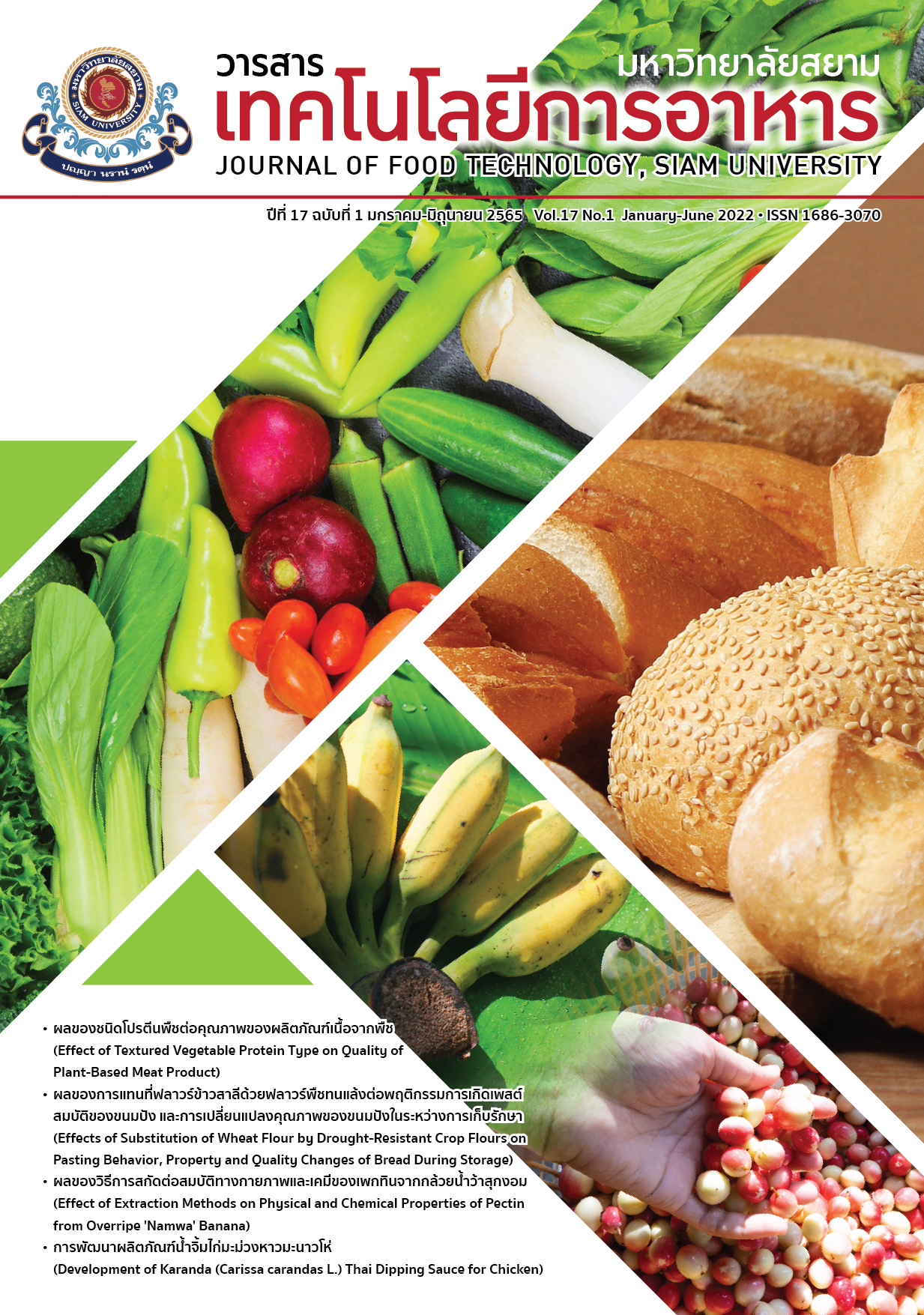Effect of Textured Vegetable Protein Type on Quality of Plant-Based Meat Product
Main Article Content
Abstract
Plant-based meat products have emerged as one of the fast-growing industries, and they are made from a variety of artificial meats or textured vegetable proteins, with different characteristics. The effect of textured vegetable protein types (soy protein A, soy protein B, pea protein A, pea protein B and wheat protein) on texture profile analysis, protein content, moisture content, color and sensory liking scores of plant-based meat products was investigated in this study. Plant-based meat products prepared from soy protein B showed higher hardness and chewiness than other proteins (p<0.05). The product has a high protein content about 15.7% and a moisture content of 60-70%. The liking scores for appearance, nutty flavor/wheat flavor, taste, texture and overall liking were higher than other proteins. With the exception of the meat color liking score, plant-based meat products prepared from pea protein A received the second-highest score (p>0.05). In addition, 75% of consumers accept plant-based meat products prepared from soy protein B. This research shows that it can be further developed into plant-based meat products.
Article Details

This work is licensed under a Creative Commons Attribution-NonCommercial-NoDerivatives 4.0 International License.
Copyrights of all articles in the Journal of Food Technology available in print or online are owned by Siam University and protected by law.
References
Bakhsh, A., Lee, S.J., Lee E.Y., Hwang, Y.H. and Joo, S.T. (2021). Traditional plant-based meat alternatives, current, and future perspective: a review. Journal of Agriculture & Life Science. 55(1): 1-10.
Riaz, M.N. (2011). Texturized vegetable proteins. In: Phillips, G.O., Williams, P.A. (ed.). Handbook of food proteins. Cambridge: Woodhead Publishing Limited.
Egbert, R. and Borders, C. (2006). Achieving success with meat analogs. Food Technology. 60(1): 28-34.
Asgar, M.A., Fazilah, A., Huda, N., Bhat, R. and Karim, A.A. (2010). Nonmeat protein alternatives as meat extenders and meat analogs. Comprehensive Reviews in Food Science and Food Safety. 9(5): 513-529.
Nasrabadi, M.N., Doost, A.S. and Mezzenga, R. (2021). Modification approaches of plant-based proteins to improve their techno-functionality and use in food products. Food Hydrocolloids. 118: 106789.
Featherstone, S. (2015). Ingredients used in the preparation of canned foods: textured vegetable proteins. a complete course in canning and related processes (4th ed.). Cambridge: Woodhead Publishing.
Kitcharoenthawornchai, N. and Harnsilawat, T. (2015). Characterization of meat analogue nugget: effect of textured vegetable protein. Food and Applied Bioscience Journal. 3(2): 121-129.
Hidayat, B.T., Wea, A. and Andriati, N. (2018). Physicochemical, sensory attributes and protein profile by SDS-PAGE of beef sausage substituted with texturized vegetable protein. Food Research. 2(1): 20-31.
Omwamba, M., Mahungu, S.M. and Faraj, A.K. (2014). Effect of texturized soy protein on quality characteristics of beef samosas. International Journal of Food Studies. 3(1): 74-81.
Yeater, M., Casco, G., Miller, R.K. and Alvarado, C.Z. (2017). Comparative evaluation of texture wheat ingredients and soy proteins in the quality and acceptability of emulsified chicken nuggets. Poultry Science. 96(12): 4430-4438.
Sarteshnizi, R.A., Hosseini, H., Amin, M.K. and Narges, K. (2015). A review on application of hydrocolloids in meat and poultry products. International Food Research Journal. 22(3): 872-887.
Kim, T.K., Shim, J.Y., Hwang, K.E., Kim, Y.B., Sung, J.M., Paik, H.D. and Choi, Y.S. (2018). Effect of hydrocolloids on the quality of restructured hams with duck skin. Poultry Science. 97(12): 4442-4449.
Majzoobi, M., Talebanfar, S., Eskandari, M. H. and Farahnaky, A. (2017). Improving the quality of meat-free sausages using κ-carrageenan, konjac mannan and xanthan gum. International Journal of Food Science and Technology. 52(5): 1269-1275.
Bakhsh, A., Lee, S.J., Lee, E.Y., Sabikun, N., Hwang, Y.H. and Joo, S.T. (2021). A novel approach for tuning the physicochemical, textural, and sensory characteristics of plant-based meat analogs with different levels of methylcellulose concentration. Foods. 10(3): 560.
Cavallini, V., Hargarten, P.G. and Joehnke, J. Vegetable protein meat analog. (2006). [Online] Available from https://patents.google.com/patent/US7070827B2/en.
Bohrer, B. M. (2019). An investigation of the formulation and nutritional composition of modern meat analogue products. Food Science and Human Wellness. 8: 320–329.
Adden, B., Hübner-Keese, B., Förtsch, S., Knarr, M. (2020). Cellulosics. In: Phillips, G. O., Williams, P.A. (eds.), Handbook of Hydrocolloids. Cambridge: Woodhead Publishing Limited.
Sakai, K., Sato, Y., Okada, M. and Yamaguchi, S. (2021). Improved functional properties of meat analogs by laccase catalyzed protein and pectin crosslinks. Scientific Reports. 11: 16631.
AOAC. (2000). Official Methods of Analysis (7th ed.). The Association of Official Analytical Chemists, Gaithersburg, MD, USA.
AOAC. (2019). Official Methods of Analysis (21st ed.). The Association of Official Analytical Chemists, Gaithersburg, MD, USA.
Bourne, M. (2002). Food Texture and Viscosity Concept and Measurement (2nd ed.). Academic Press, USA.
Samard, S. and Ryu, G.H. (2019). Physicochemical and functional characteristics of plant protein-based meat analogs. Journal of Food Processing and Preservation. 43(10): e14123.
Szczesniak, A. S. (1963). Classification of textural characteristics. Journal of Food Science. 28(4): 385-389.


